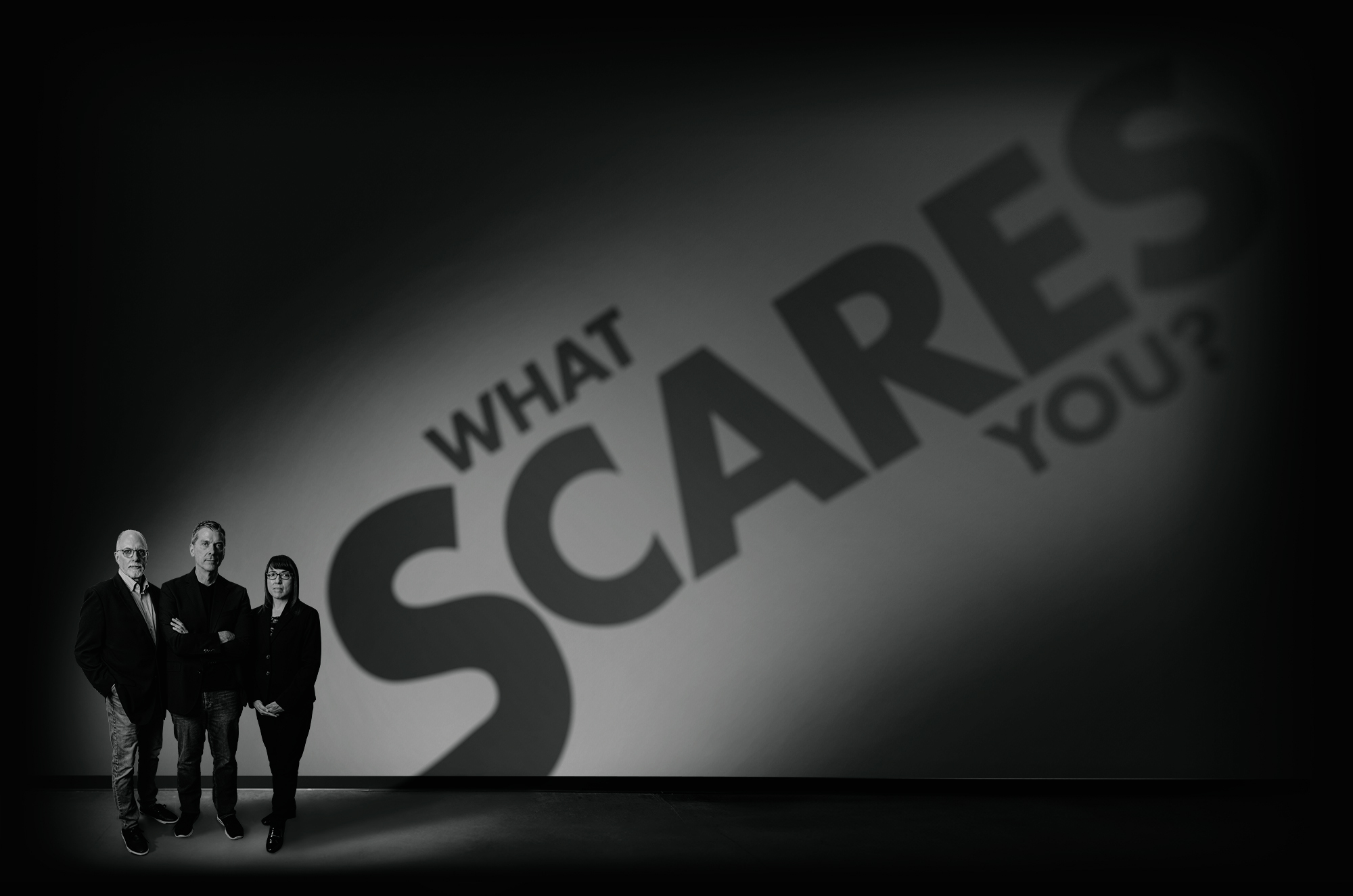
What Scares You?
Over the past decade, three Chapman researchers have explored the psyche of America, uncovering the top fears that haunt the nation.




The Chapman University survey of American fears has been changing how sociologists think about the impact of fear.
Top 10 Fears of 2024 (% Of Very Afraid or Afraid)
- Corrupt Government Officials (65.2%)
- People I Love Becoming Seriously Ill (58.4%)
- Cyberterrorism (58.3%)
- People I Love Dying (57.8%)
- Russia Using Nuclear Weapons (55.8%)
- Not Having Enough Money for the Future (55.7%)
- U.S. Becoming Involved in Another World War (55.0% — TIED)
- North Korea Using Nuclear Weapons (55.0% — TIED)
- Terrorist Attack (52.7%)
- Biological Warfare (52.5%)
Sharks, clowns, public speaking—do you know what Americans are really afraid of?
According to the researchers on the Chapman University Survey of American Fears, the nation’s number one fear in 2024 is corrupt government officials. This isn’t news to the members of “Team Fear.” It’s topped the study every year since 2015.
“Fear of corrupt government officials, that’s always up there,” says Christopher Bader, professor of sociology and the lead investigator on the project. “We think that is reflecting an overall sense amongst people, regardless of political affiliation, that the government is just not working, it is corrupt.”
Fears about election outcomes are pervasive in 2024, regardless of political affiliation.


While people are perennially concerned about not having enough money, the fear of economic collapse—last year’s number two fear—has dropped out of the top 10 list. Meanwhile, fear of cyberterrorism has grown by 9%, moving it into third position in the rankings.

Christopher Bader, professor of sociology, speaks about surprises from this year’s survey.
“
Christopher Bader, professor of sociology, speaks about surprises from this year’s survey.


10 YEARS OF STUDYING AMERICAN FEARS
Chapman’s Survey of American Fears has been tracking the nation’s most common fears since 2014. It has since captured the attention of both academic researchers and the national imagination. Dozens of peer-reviewed articles have cited the study’s data, and it has been featured in print, broadcast and online media, including the New York Times, The Huffington Post, CBS This Morning, Yahoo News, NPR, Good Housekeeping, the Washington Post, USA Today, Rolling Stone and TIME.


Ten years ago, the Chapman investigators started to question long-held assumptions about what people were really afraid of. Their curiosity was piqued by an increase in fear-based political messaging in the media, including political ads that preyed upon fears to sway voters. Prior to the study, it was popularly believed that Americans’ greatest fear was public speaking.
“When we released our first list, we got a lot of blowback from people saying, ‘no, public speaking is what people are most afraid of,’” says Ed Day, associate professor of sociology. But public speaking only comes in at 29% on this year’s list, just a few percentage points below a fear of sharks.
Other scholars had written about the subject of fear, but those articles were usually based on data from a single survey. Chapman’s Team Fear wanted to do what no one had done before: track how America’s fears were changing over time.
Now, with 10 years of data to draw on, sociologists can identify patterns that reveal how fear influences—and is influenced by—current events, cultural clashes and propaganda.
One example of how fears often spike in reaction to current events was in 2017, when environmental fears dominated the top 10 list for the first time.
Fears surrounding climate change rose in 2018, following policy changes in Washington that weakened environmental protection laws.
“This was likely due to policy changes in Washington,” said Ann Gordon. “The Trump Administration had charted a drastically different path from the previous administration and ordered the U.S. Environmental Protection Agency not to enforce major pollution laws. They fired the EPA’s entire Science Advisory Board, and they withdrew the United States from the Paris Agreement on climate. In reaction to that, you see environmental fears spike.”
Another example is how, for many years, the fear of mass shootings was the fastest growing fear in America.
“This was really a reflection of America’s gun problem and the gun violence in schools, shopping centers, houses of worship and other public places,” said Day.
Over time, the study has made it increasingly clear how important fear is in shaping public policy and discourse, and how important it will be going forward in a social media age and in the current political climate, said Bader.
“When we went into this, we thought it would be useful,” he said, “But, and I think this is perhaps an unfortunate thing, we’ve learned that, over the last 10 years, fear has become a bigger and bigger part of American society.”
THE IMPACT OF FEAR ON PUBLIC POLICY
While the study demonstrates how American fears rise and fall due to current events, it sometimes shows the opposite— that what people fear doesn’t always reflect reality. This disparity is glaringly obvious when it comes to fears about crime.
“The vast majority of our respondents said that crime rates are rising dramatically, and they’re just wrong,” said Bader. “Serial killings have been going down. Stranger abductions of children have been going down. Murders by strangers have been going down. Sexual assaults by strangers have been going down.”
One of the reasons for this misperception is an increased dependence on social media and news sites that rely on page views and engagement for revenue. Articles with attention grabbing headlines are more likely to be shared, and a flood of dire warnings keep readers glued to their phones in a habit that’s become known as “doom scrolling”.


But the problem with this disconnect between fact and fear is that it can focus attention in the wrong places.
“We are so focused on serial killers, we give a lot of resources to the FBI Behavioral Analysis Unit,” Bader said. “By comparison, we are spending far too little on domestic violence programs, but you are far, far more likely to be a victim of domestic violence than to be a victim of a serial killer. To me, this is a case where our fears are directly hurting us. We are so focused on stranger danger that it leads us to spend resources in the wrong way.”
But the team hopes that the results of their research can be used to counteract some of the influence these unfounded fears can have in the public sphere.
“We have shared the results with FEMA, the Red Cross, the National Weather Service and emergency managers across the country, who have used the information in their efforts to better prepare America for disasters,” said Ann Gordon, associate professor of political science. She is currently working with the National Weather Service on framing wildfire messaging to effectively warn the public in a way that promotes protective action, not fear.

“


CHAPMAN STUDENTS STEP UP
For a project with such an enduring impact, it may surprise some people to know that the Survey of American Fears started as a class project for Bader’s undergraduate students.
“We all had an interest in fear because of the research that we do,” said Day, whose studies focus on criminology. Gordon’s research focuses on terrorism and disasters, and Bader has been studying paranormal beliefs for over 20 years. “It was Chris who was thinking more directly about it through his work with people who study the paranormal, so he folded it into a course and said, ‘Let’s have students get involved.’”
And so the original list of fears that sits at the core of the annual survey was put together by students in the class, guided by faculty who offered expertise on survey design and data analysis.
Chapman students continue to participate in all aspects of the survey.
“They research and develop new content, analyze the data, work on group and individual research projects and present and publish their work,” said Gordon, who coauthored a book, “Homeland Insecurity,” with one of her students, Kai Hamilton Gentry ’17, that expands on the Fear Study data.
Additionally, the data have been used in hundreds of research papers and senior theses at Chapman. “Faculty use these data in classes to teach research methods, or for students to do their senior seminar projects. It really helps them to build a competitive profile for the job market or their applications for grad school and law school,” said Gordon, adding that a paper by Roxy Amirazizi ’22 was cited in The New York Times in 2021.
It is, perhaps, a little bit ironic that the Study of American Fears has received so much media attention when one of its biggest lessons is a warning about how media can influence what people are afraid of. Yet, especially in an election year, with campaign messaging saturating every media channel, it’s more important than ever that individuals understand how fears are being used to manipulate their choices at the polls.
But the fear study offers hope that we don’t need to be controlled by our fears.
“Our media usage habits stoke fears and we’ve seen social media, cable news and local TV news elevate a broad range of fears,” said Gordon. “So one lesson is to limit screen time and put down our smartphones.”

“


To learn more about the fear study, visit the Chapman Survey of American Fears website.



What Scares @chapmanu?


Story by Stace Dumoski
Photography and videography by Adam Hemingway
Design by Cindy Harvard and Julie Kennedy
Media Contacts
Strategic Marketing and Communications
1 University Drive
Orange, CA 92866
Contact Us
Newsroom Site
Your Header Sidebar area is currently empty. Hurry up and add some widgets.
